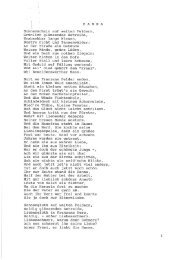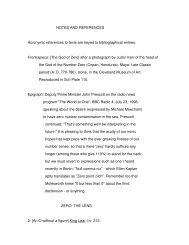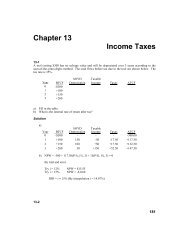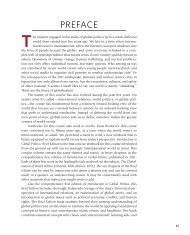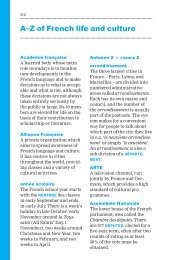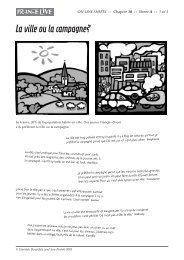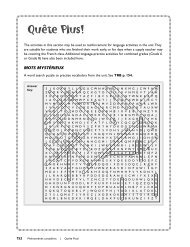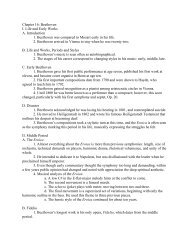CHAPTER 3 Consumer Preferences and Choice
CHAPTER 3 Consumer Preferences and Choice
CHAPTER 3 Consumer Preferences and Choice
Create successful ePaper yourself
Turn your PDF publications into a flip-book with our unique Google optimized e-Paper software.
03-Salvatore-Chap03.qxd 08-08-2008 12:41 PM Page 79<br />
FIGURE 3.11 Rationing In the absence of rationing, the individual<br />
maximizes satisfaction at point B, where indifference curve U1 is tangent to<br />
budget line JK, <strong>and</strong> consumes 2X <strong>and</strong> 6Y (as in Figure 3.8). If the<br />
government did not allow the individual to purchase more than 1X per<br />
week, the budget line becomes JLK ′ , with a kink at point L. The highest<br />
indifference curve that the individual can reach with budget line JLK ′ , is<br />
now U0 at point L, by consuming 1X <strong>and</strong> 8Y.<br />
✓ Concept Check<br />
Can rationing lead to<br />
a black market?<br />
<strong>CHAPTER</strong> 3 <strong>Consumer</strong> <strong>Preferences</strong> <strong>and</strong> <strong>Choice</strong> 79<br />
The effect of rationing on utility maximization <strong>and</strong> consumption can be examined<br />
with Figure 3.11. In the absence of rationing, the individual maximizes satisfaction at<br />
point B, where indifference curve U1 is tangent to budget line JK, by consuming 2X<br />
<strong>and</strong> 6Y (as in Figure 3.8). Good X could refer to hours per week of lawn watering (in<br />
absence of an automatic water sprinkler system), while good Y could refer to hours per<br />
week of TV viewing. If the government did not allow the individual to use more than<br />
1X per week, the budget line becomes JLK ′ , with a kink at point L. Thus, rationing<br />
changes the constraints under which utility maximization occurs. The highest indifference<br />
curve that the individual can reach with budget line JLK ′ is now U0 at point L,by<br />
consuming 1X <strong>and</strong> 8Y. In our water rationing case, this refers to one hour of lawn<br />
watering <strong>and</strong> eight hours of TV viewing per week. With water rationing, the incentive<br />
arises to illegally water lawns at night under the cover of darkness. On the other h<strong>and</strong>,<br />
gasoline rationing during 1974 <strong>and</strong> 1979 led to long lines at the gas pump <strong>and</strong> to black<br />
markets where gasoline could be purchased illegally at a higher price without waiting.<br />
Thus, rationing leads to price distortions <strong>and</strong> inefficiencies.<br />
If rations were 2X or more per week, the rationing system would not affect this<br />
consumer since he or she maximizes utility by purchasing 2X <strong>and</strong> 6Y (point B in the<br />
figure). Rationing is more likely to be binding or restrictive on high-income people<br />
than on low-income people (who may not have sufficient income to purchase even the<br />
allowed quantity of the rationed commodity). Thus, our model predicts that highincome<br />
people are more likely to make black-market purchases than low-income people.<br />
Effective rationing leads not only to black markets but also to “spillover” of<br />
consumer purchases on other goods not subject to rationing (or into savings). Both<br />
occurred in the United States during the 1974 <strong>and</strong> 1979 gasoline rationing periods. As<br />
pointed out in Section 2.7, allowing the market to operate (i.e., letting the price of the<br />
commodity reach its equilibrium level) eliminates the inefficiency of price controls<br />
<strong>and</strong> leads to much better results.<br />
Sources: “Trickle-Down Economics,” Wall Street Journal, August 23, 1999, p. A14; “Water Rights May<br />
Become More Liquid,” Wall Street Journal, February 15, 1996, p. A2; W. C. Lee, “The Welfare Cost of<br />
Rationing-by-Queuing Across Markets,” Quarterly Journal of Economics, July 1987; J. Brewer, et al.,<br />
“Water Markets in the West: Prices, Trading, <strong>and</strong> Contractual Forms,” NBER Working Paper No. 13002,<br />
March 2007, <strong>and</strong> M. Greenstone, “Tradable Water Rights,” Democracy Journal, No. 8, Spring 2008, pp. 1–2.<br />
Quantity of Y<br />
Q Y<br />
10<br />
8<br />
6<br />
3<br />
0<br />
J<br />
L<br />
1<br />
K 9<br />
2<br />
B<br />
K<br />
U 1<br />
U 0<br />
5 8 Q X<br />
Quantity of X



